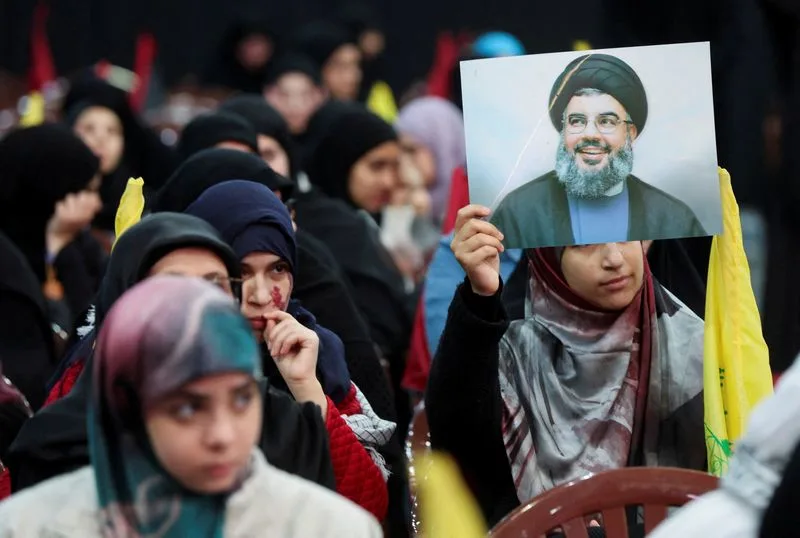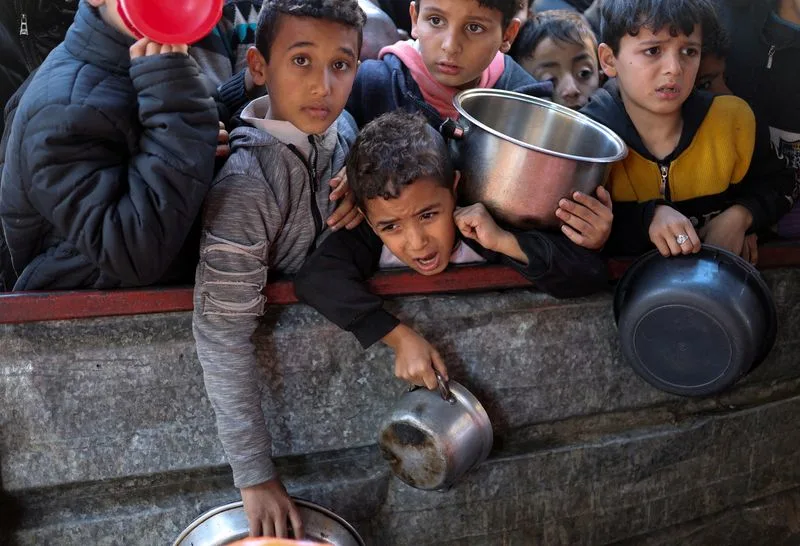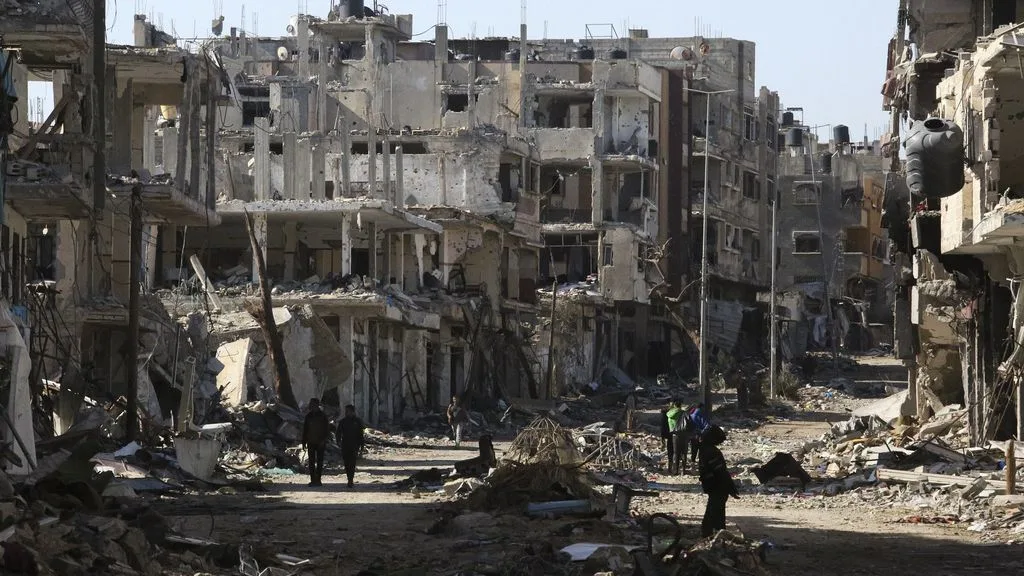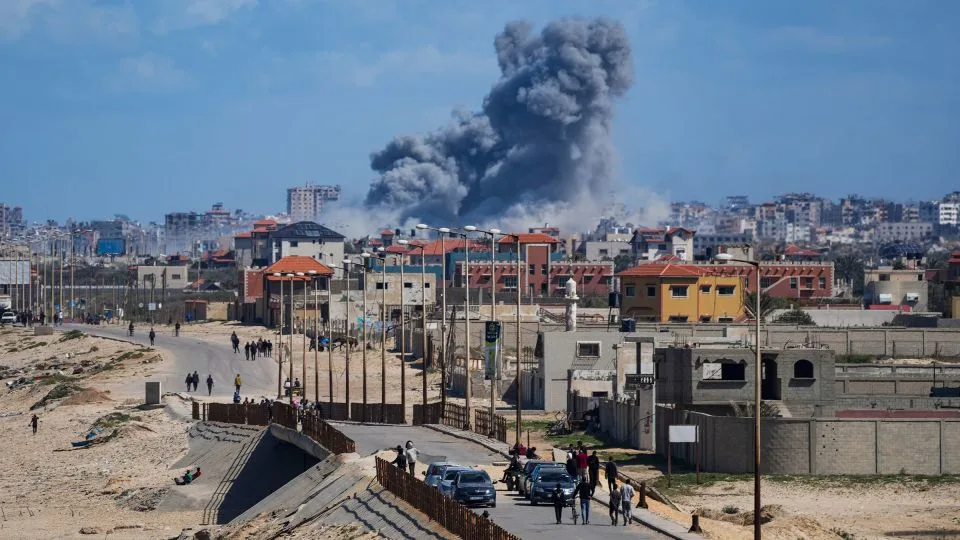The US plan to build a floating port off the Gaza coast is a bold move, reminiscent of the Mulberry harbours built after D-day in Normandy, but there are serious concerns that what relief it brings will be too little too late for Palestinians facing starvation.
“When we talk about the sea route, it’s going to take weeks to set up and we are talking about a population that is starving now. We have already seen children dying of hunger,” said Ziad Issa, the head of humanitarian policy at the ActionAid charity.
Related: Biden to announce US will build port on Gaza shore for large-scale aid delivery
US officials have presented the plan as Washington taking leadership and “not waiting for the Israelis”, but the Israelis will still have a say on how effective it is in delivering aid, especially in the north, where the threat of famine is most imminent.
Israeli inspectors will be in the Cypriot port of Larnaca, scrutinising cargoes of aid going into southern Gaza, and the inspections will provide Israel a tool with which to regulate the flow in the name of security vetting.
That might be harder for Israel to do when dealing directly with US military logistics officers rather than aid officials, but there are many other ways the Israeli government, a coalition that includes ministers who oppose any aid entering Gaza, can play an obstructionist role.
“People say this is a complex situation, but it’s very simple,” Issa said. “Israel is not allowing aid to get to the Gaza Strip.”
The plan involves US military engineers building a floating pier off the Gaza shore, on which shipborne food aid can be unloaded from ships from Larnaca, and a causeway for it to be driven onshore. The question is, then what? Most of Gaza’s population, most of whom have been displaced several times over, are not concentrated at the beach.
“Who is going to distribute it?” asked Jeremy Konyndyk, a former senior aid official in the Biden administration, and now president of the Refugees International aid advocacy group. “The aid organisations’ presence in northern Gaza is pretty close to zero because the Israelis have wanted everyone out and then have been restricting access to the north ever since.”
The proposed maritime aid corridor, Konyndyk said, “doesn’t obviate the problem of obstruction by Israel, but rather than being a problem at the entry point, now it’s going to be a problem at the distribution stage”.
“You need drivers that don’t exist, trucks that don’t exist feeding into a distribution system that doesn’t exist,” he added.
In the short term, it might involve communities near the shore distributing the food among themselves.
To get assistance around the strip would not just require trucks and drivers but also some sort of security, as desperation has taken over and looting is rife. The Israeli army has escorted some small NGO food deliveries, but an attempted delivery on 29 February on the outskirts of Gaza City ended with the killing of at least 115 Palestinians after Israeli soldiers opened fire after people rushed for the food trucks.
The Israel Defense Forces (IDF) claimed most of the casualties had been caused by a crush, but UN officials and doctors said the overwhelming majority of injuries were gunshot wounds.
“Even if there is a ceasefire, it is going to be very messy for the initial period, because the security apparatus that used to exist has collapsed, the clan structures and community leaders who would provide assurances and safety have also been very splintered,” Konyndyk said. “And from what we saw in the incident last week, the Israeli military is not a reliable security guarantor.
“It’s very tough and I think it’s worthwhile to try this,” he added. “I think they’re going to be figuring a lot of it out as they go, and I think that’s OK. I’m in favour of anything that helps at this point.
“But let’s also just be realistic about why this is necessary, and it’s necessary because of five months of obstruction of access in the north by the IDF and five months of intentional degradation of humanitarian capacity in the strip,” Konyndyk said. “And frankly the US has tolerated that for five months.”
Israel ‘fully supports’ the facility
On Thursday, an Israeli official said the country welcomes the plan to deliver humanitarian aid by sea and will coordinate the development of the project with the US.
Israel “fully supports” creation of such a facility, the official said on condition of anonymity.
UNRWA, the UN’s agency for Palestinian refugees, says Gaza needs at least 400 to 500 trucks a day to meet the most basic needs of its citizens.
Gaza used to receive roughly 500 trucks with supplies daily before the war when the enclave still had local sources of fresh water and agricultural products.
The World Health Organisation (WHO) earlier this week reported that at least 15 children have died of malnourishment and dehydration at Kamal Adwan Hospital in northern Gaza, an area worst affected by fighting.
WHO screenings at health facilities in the north found one in six children under the age of two to be acutely malnourished.
US frustrated by lack of Israeli co-operation
Mr Biden has pleaded with Israel, which has effectively sealed off Gaza, to make it easier to bring aid trucks into the stricken areas.
Frustrated by an apparent lack of cooperation, the US has carried out two airdrops of aid over the past week and Israeli cabinet minister Benny Gantz, who met vice-president Kamala Harris on Monday, said he was “surprised” how angry the US was over the impasse in Gaza.
Experts warned the aid effort will be challenging.
“This is a huge military undertaking for the US, fraught with risks at sea and at delivery in Gaza, and it’s a step being taken to effectively break a siege enforced not by an enemy, but an ally,” Charles Lister, a Middle East analyst, wrote on X.
The Biden administration is coming under strong domestic pressure to restrain Israel and step up humanitarian support for Palestinian civilians who have borne the brunt of Israel’s military response to the Oct 7 attack by Hamas.
Democrat strategists’ fears that Mr Biden could pay dearly at the ballot box appeared to be confirmed on Super Tuesday when around 100,000 people in the crucial swing state of Michigan voted “uncommitted” in the Democratic Primary.
Struggling in the polls already, Mr Biden can ill afford to lose the support of young and black voters who made up the coalition that swept him to power in 2020.
Over the weekend Kamala Harris, the vice president, called for an immediate ceasefire in Gaza when she spoke in Selma, Alabama.
The Gaza crisis has threatened to overshadow Mr Biden’s State of the Union speech on Thursday evening in which he will seek to press his case for re-election in November with a raft of eye-catching domestic initiatives.
In the televised speech, which is one of the key events in the US political calendar, the president will hail that the US avoided the recession that had been predicted by economic forecasters.
Seeking to draw a distinction between his vision and that of Donald Trump, Mr Biden will announce more “green investment” paid for by raising taxes on the ultra wealthy and corporations, who will see the rate increase from 21 to 28 per cent.
But voters remain sceptical about “Bidenomics”, with Mr Trump enjoying a healthy lead in the category of which candidate can best handle the economy.
In an attempt to burnish his image, Mr Biden wrote on X that he had taken advice on how to deliver the State of the Union speech from actors who have portrayed the president on screen including Morgan Freeman and Michael Douglas.
“You may have heard I’ve got a big speech coming up,” Mr Biden wrote “So, I thought I would hear from some folks who have done the job before — sort of.”
LINK: https://www.yahoo.com/news/us-build-port-off-gaza-000912924.html?






